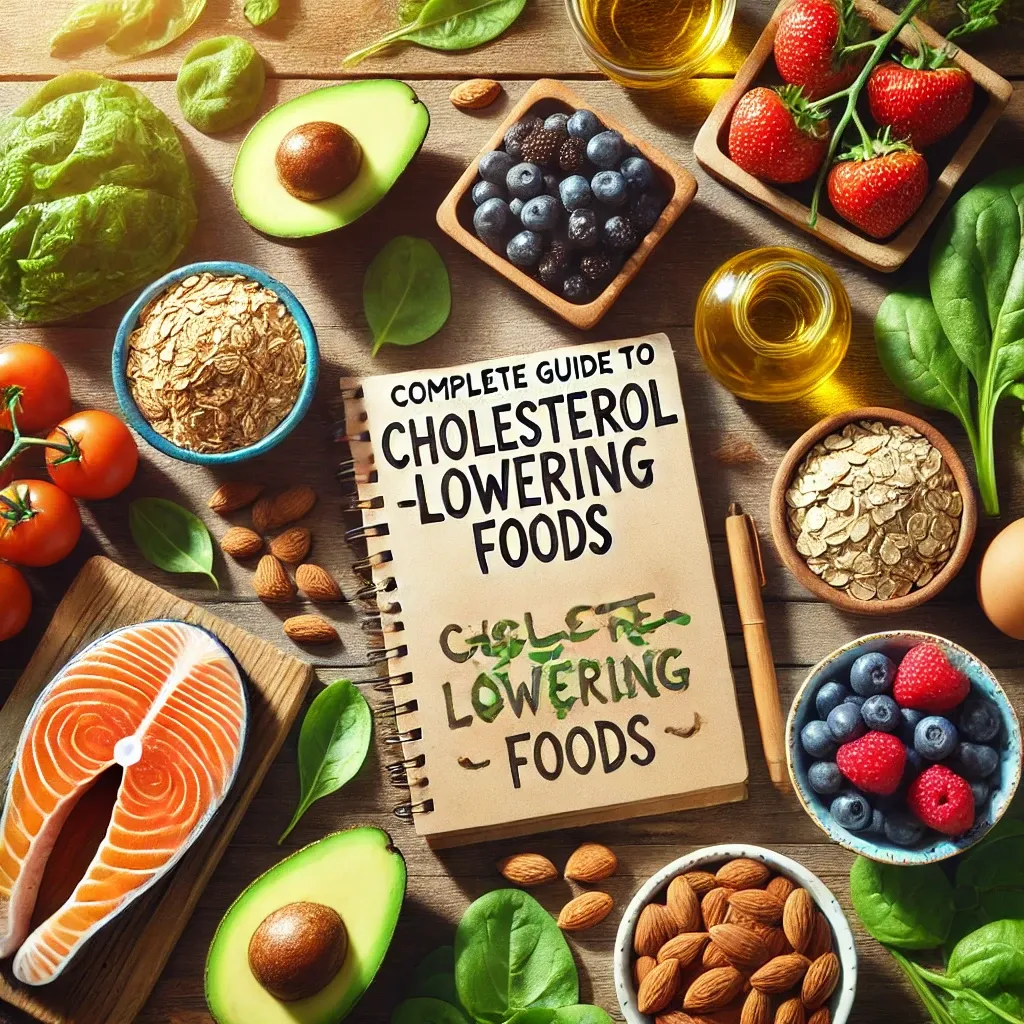📋 Table of Contents
Cholesterol is often known as something “bad,” but in fact, it’s one of the essential components our body needs. The problem arises when there is too much LDL—so-called “bad” cholesterol. In this case, dietary management plays a truly crucial role. How about finding natural ways to regulate it through food before relying on medications?
As of 2025, many foods have been proven effective in lowering cholesterol levels. More than just eating vegetables, it’s important to know which components help and what specific foods to consume. That’s why today, I’m going to systematically introduce foods that lower cholesterol 🍀
In my opinion, knowing this kind of information in advance can be the shortcut to reducing hospital visits later on. Simply changing the ingredients we eat regularly can significantly improve cardiovascular health. Managing cholesterol is no longer difficult!
Cholesterol and Its Identity 🤔
Cholesterol is essential for hormone production and forming cell membranes in our body. It’s naturally produced by the liver and partially obtained through food. However, when LDL cholesterol increases, it can build up on artery walls, leading to atherosclerosis. On the other hand, HDL cholesterol plays a positive role by removing LDL.
That’s why it’s not just about “eliminating cholesterol,” but rather “increasing good cholesterol and decreasing bad cholesterol.” This balance is key to maintaining health. Especially lowering the concentration of LDL in the blood is vital in preventing cardiovascular diseases.
Blocked arteries may not show symptoms early on but can later develop into serious conditions like myocardial infarction or stroke. That’s why managing it through diet is crucial. Simply changing the foods on your daily plate can make a huge difference in your health.
Especially since the 2020s, awareness of “managing health through diet” has greatly expanded, and many studies back up its effectiveness. Let’s now take a look at the foods that help control cholesterol.
🥚 Cholesterol Type Comparison Table
| Type | Role | Health Impact | Recommended Level |
|---|---|---|---|
| LDL | Delivers cholesterol to blood vessels | High levels may cause artery blockage | Below 100 mg/dL |
| HDL | Removes LDL, carries it to the liver | The higher, the better for heart health | Above 60 mg/dL |
As seen in the table, understanding the difference between these two cholesterols is essential for making dietary choices. Now let’s dive into foods that help lower LDL! Up next are foods rich in dietary fiber 🌾
Foods Rich in Dietary Fiber 🌾
Dietary fiber plays a direct role in lowering cholesterol. Especially soluble fiber blocks cholesterol absorption in the gut and helps excrete it. Oats, barley, legumes, apples, and citrus fruits are representative fiber-rich foods.
Oats contain a compound called “beta-glucan,” well known for effectively lowering cholesterol. Consuming more than 3g of oats per day can positively impact LDL levels. Nowadays, it’s easily available in cereals, bars, and porridge.
Fruits like apples and pears are also rich in dietary fiber. Eating them with the skin is even better. A type of soluble fiber called pectin absorbs cholesterol and helps excrete it from the body. Simply eating whole fruits can greatly benefit heart health 🍎
Legumes are fantastic too. Lentils, chickpeas, black beans are high in both protein and fiber, which help manage both blood sugar and cholesterol. They’re essential in vegetarian diets for managing both nutrients and cholesterol levels.
🌾 Dietary Fiber Food Comparison Table
| Food | Fiber Type | Amount per Serving | Cholesterol-Lowering Effect |
|---|---|---|---|
| Oats | Soluble (Beta-glucan) | 3g / 1 cup | Up to 10% LDL reduction |
| Apple | Soluble (Pectin) | 4g / 1 fruit | Absorbs blood fats |
| Lentils | Insoluble + Soluble | 8g / 1/2 cup | Reduces total cholesterol |
As shown, fiber is found in a variety of foods, and regular consumption greatly benefits vascular health. Up next, let’s talk about “healthy fats” that many people are curious about 🥑
Plenty of Healthy Fats! 🥑
Not all fats are bad! In fact, healthy fats are essential for our bodies. Unsaturated fatty acids in particular help lower bad cholesterol (LDL) and raise good cholesterol (HDL). Avocados, nuts, and olive oil are prime examples.
Avocados are called “butter of the forest” due to their high fat content, but most of it is unsaturated. Eating about half an avocado a day is effective in lowering blood cholesterol levels. Thanks to their creamy texture, they’re great in salads or smoothies!
Olive oil is the core of the Mediterranean diet. Its main fatty acid, oleic acid, also has anti-inflammatory effects. It’s best used raw in salads or dishes to minimize nutrient loss — 1 to 2 tablespoons a day is recommended 🫒
Nuts are a must too! Almonds, walnuts, and pistachios are rich in plant-based omega-3 fatty acids and vitamin E. Eating a handful a day can positively influence heart health. Just make sure to avoid salted or processed varieties.
🥜 Healthy Fat Food Comparison Table
| Food | Fat Type | Recommended Intake | Cholesterol Impact |
|---|---|---|---|
| Avocado | Monounsaturated Fat | 1/2 piece/day | Lowers LDL, raises HDL |
| Olive Oil | Monounsaturated Fat | 1–2 tbsp/day | Prevents heart disease |
| Walnuts | Polyunsaturated Fat | 1 handful/day | Reduces inflammation, lowers LDL |
Consistently including healthy fats in your meals can reduce bad cholesterol and keep blood vessels healthy. Now let’s talk about foods rich in “plant sterols” 🌱 — they directly block cholesterol absorption!
Foods Rich in Plant Sterols 🌱
Plant sterols are naturally occurring compounds in plants that have a similar structure to cholesterol. Because of this, they block cholesterol absorption in the gut and help with its natural elimination. Foods rich in plant sterols are very effective in lowering LDL cholesterol.
Examples include sunflower seeds, sesame seeds, avocados, almonds, and vegetable oils (especially corn and sunflower oil). Nowadays, processed products enriched with plant sterols like margarine, milk, and yogurt are also widely available.
Studies have shown that consuming more than 2g of plant sterols daily can lower LDL cholesterol by around 10%. Reducing saturated fat while increasing sterol intake enhances the effect. The key is consistency 🌿
This compound is rarely found in animal-based foods, so a plant-based diet is essential to benefit from it. Including a handful of nuts, some seeds, and plant oils daily makes natural intake very manageable.
🌱 Plant Sterol Food Comparison Table
| Food | Sterol Content (per 100g) | Recommended Daily Intake | Cholesterol Impact |
|---|---|---|---|
| Sunflower Seeds | 270mg | 1 handful | Inhibits LDL absorption |
| Corn Oil | 961mg | 1 tablespoon | Reduces total cholesterol |
| Almonds | 143mg | 1 handful | Protects cardiovascular health |
While more supplements with plant sterols are appearing, the best method is still through whole foods.
Healthy Soy-Based Foods 🫘
Soybeans have long been loved as a health food. They are especially well-known for their effectiveness in lowering cholesterol. Soy contains plant-based protein and a powerful antioxidant called isoflavone. Isoflavones lower LDL cholesterol while also increasing the elasticity of blood vessels.
Soy-based products such as tofu, soy milk, and soy noodles are also highly effective. Many studies show that consuming 25g of soy protein per day helps lower cholesterol. Since they can replace animal protein, they are also excellent for preventing cardiovascular disease.
Soy is also a great choice for those following a plant-based diet. It provides sufficient protein and fat without meat, helps reduce saturated fats, and keeps you full for longer — great for weight control too!
Fermented soy products like natto and doenjang (fermented soybean paste) also contain beneficial bacteria for gut health. Natto contains an enzyme called “nattokinase,” which promotes blood circulation and prevents blood clot formation.
🫘 Soy-Based Food Comparison Table
| Food | Main Ingredients | Daily Recommended Amount | Cholesterol Impact |
|---|---|---|---|
| Soy Milk | Soy protein, isoflavone | 200ml | Reduces LDL levels |
| Tofu | Plant-based protein | 100g | Cholesterol substitute |
| Natto | Nattokinase, probiotics | 1 pack | Improves blood circulation |
Soy foods can easily be incorporated into daily meals, making them very practical. Next, let’s look at how fruits and vegetables affect cholesterol! 🍎 If you love fruit, don’t miss this!
The Incredible Power of Fruits and Vegetables 🍎
Fruits and vegetables are rich in vitamins, minerals, antioxidants, and fiber. Soluble fiber blocks cholesterol absorption, while antioxidants reduce inflammation in blood vessels. This plays a major role in preventing LDL (bad cholesterol) oxidation.
Apples and citrus fruits are rich in soluble fiber called pectin, which excels at absorbing cholesterol and excreting it through the digestive tract. Especially if you make a habit of eating a whole apple with skin for breakfast, it helps naturally lower LDL 🍏
Berries such as strawberries, blueberries, and grapes contain polyphenols, powerful antioxidants that keep blood vessels clean and prevent LDL from sticking to vessel walls. They’re delicious and perfect as a dessert!
Green vegetables also can’t be ignored. Spinach, broccoli, and kale contain potassium, magnesium, and plant-based antioxidants that help regulate blood pressure and dilate blood vessels. Flexible vessels are crucial to prevent cholesterol buildup — daily intake is essential 🥦
🍇 Fruit & Vegetable Cholesterol-Improving Effects
| Food | Main Component | Cholesterol Effect | Additional Benefits |
|---|---|---|---|
| Apple | Pectin | Helps excrete LDL | Improves digestion |
| Blueberry | Polyphenols | Prevents LDL oxidation | Anti-inflammatory effect |
| Broccoli | Fiber, Glucosinolates | Cleanses blood vessels | Anti-cancer effects |
Fruits and vegetables can be enjoyed in many ways — raw, as juice, or in salads — so it’s easy to include them in your meals regularly.
FAQ
Q1. What is the most effective food for lowering cholesterol?
A1. Oats, avocados, nuts, plant sterol-enriched products, soy milk, natto, and apples are highly effective. Among them, oats and avocados are the most widely researched!
Q2. How long does it take to lower cholesterol levels?
A2. Changes in cholesterol levels usually appear within 4–6 weeks of dietary improvement. However, depending on individual conditions, steady practice for 3 months or more may be needed.
Q3. I have hyperlipidemia — is it okay to eat a lot of fruit?
A3. Fruits are rich in fiber and antioxidants. However, for fruits high in fructose, it’s best to eat small portions 2–3 times a day.
Q4. Where can I buy plant sterol products?
A4. Plant sterol-enriched milk, yogurt, margarine, etc., can be easily found in large supermarkets or health supplement stores.
Q5. Is cholesterol always better when it’s lower?
A5. Not necessarily. Higher HDL cholesterol is actually beneficial. The goal is to lower LDL while maintaining or increasing HDL levels.
Q6. Can I combine cholesterol-lowering foods with medication?
A6. Yes, combining diet with medication can create a synergistic effect. However, some medications may interact with certain foods like grapefruit, so caution is needed.
Q7. How many meals per day are best for cholesterol control?
A7. Eating small portions regularly at consistent times is ideal. Avoid overeating and try not to eat late at night.
Q8. Can I lower cholesterol with diet alone, without exercise?
A8. It’s possible to some extent, but combining with exercise leads to faster improvement. Aerobic exercise is especially effective for managing cholesterol levels.
We’ve now explored a variety of cholesterol-lowering foods and the reasons behind their effects! Managing your health through food isn’t hard anymore, right? How about starting with one change in your diet today? 😊

